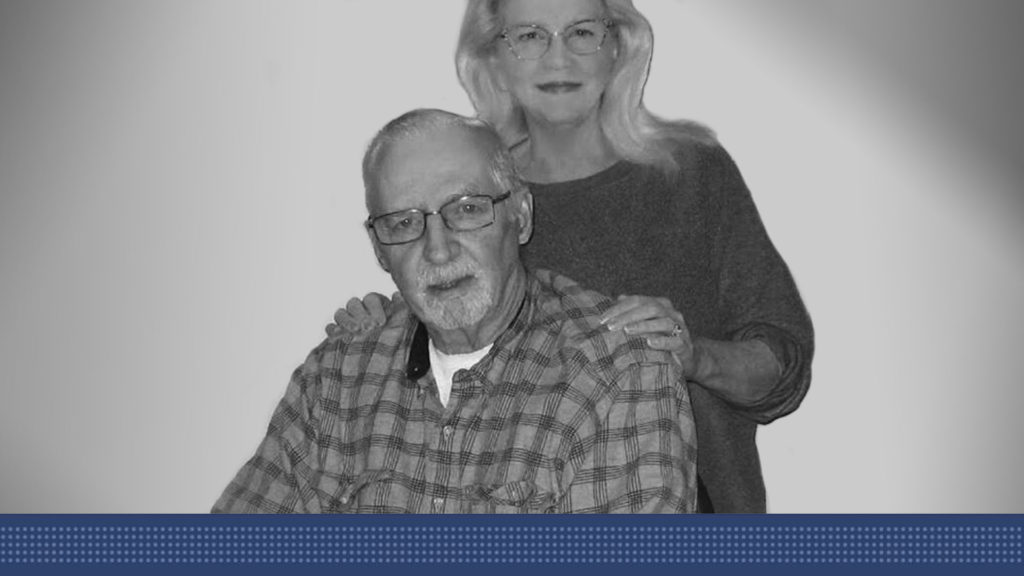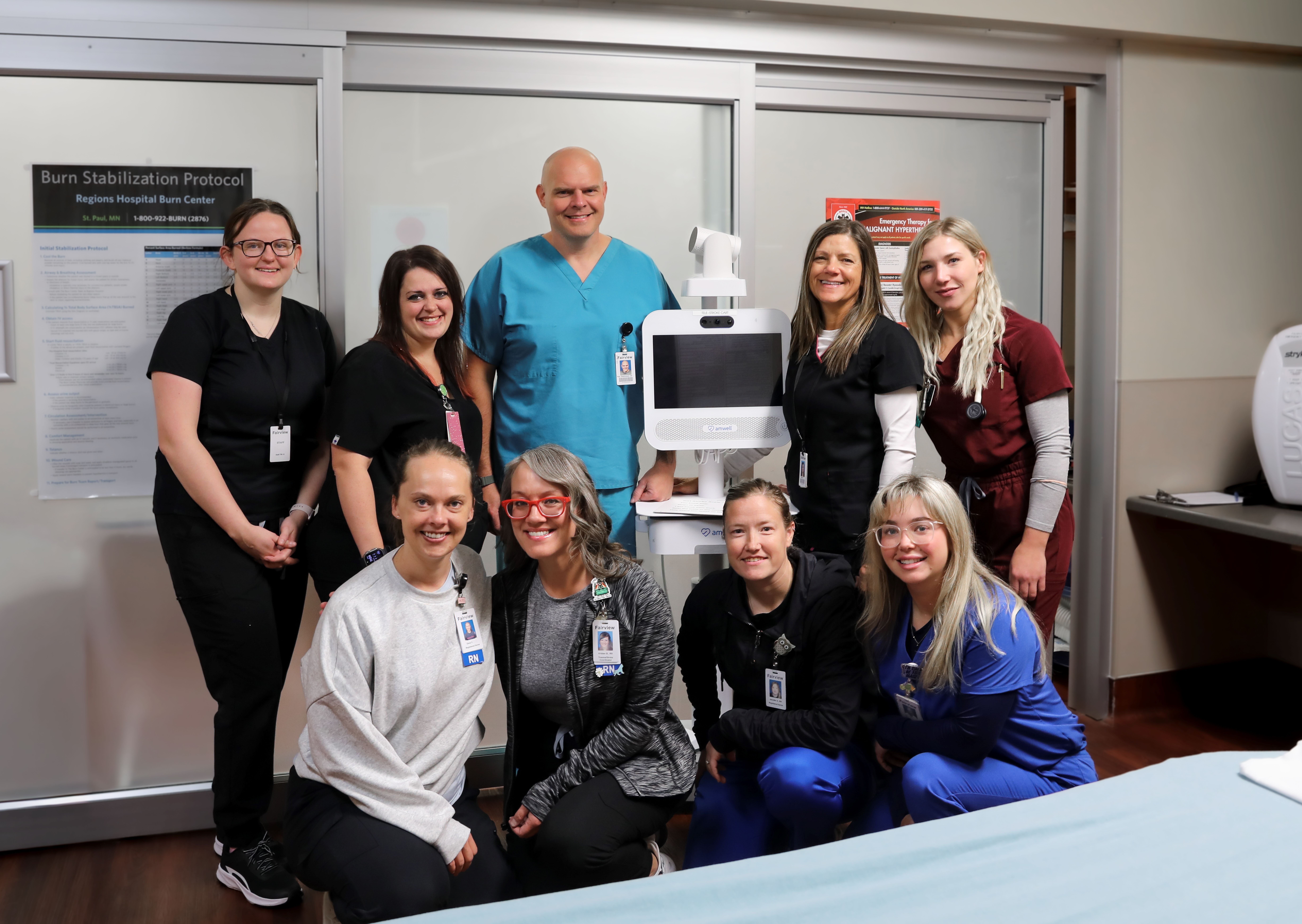It was supposed to be a normal morning for Richard and Dianne Jensen of Hibbing, Minnesota. On April 16, 2021, Richard had just finished eating his breakfast and taking his morning medication for blood pressure and cholesterol. But when his wife, Dianne, walked into the kitchen she found him leaning against the wall, his arms and face hanging downward. At first she thought he was just bending over to pick something up. When he kept not answering her, she approached and realized something was terribly wrong. Richard Jensen had just suffered an acute ischemic stroke.

Richard and Dianne Jensen of Hibbing, MN
Thankfully, Dianne realized it was a stroke and called EMS immediately. When they arrived minutes later, they set Richard down and checked his vitals. He started to open his eyes a bit, but still wasn’t appearing that he could move or talk.
“I just knew this wasn’t good and I just thought that he isn’t going to recover from this,” stated Dianne.
A new future flashed before her eyes. Dianne had witnessed strokes and their life-changing after-effects on friends and family members. She imagined wheeling him around in a wheelchair, trying to help him recollect their precious memories. They would get through it together, but their life was about to get much more difficult.
EMS quickly brought Richard to the Fairview Range Emergency Department. Thanks to the advance communication between the EMS and the Fairview Range emergency team, a room and a care team were ready and waiting when Richard arrived. They immediately assessed him and called a stroke specialist team at M Health Fairview University of Minnesota Medical Center while Richard was sent for a CT scan. When he returned from his CT scans, stroke specialists Dr. Haitham Hussein and Nasima Omar, PA-C immediately conducted a virtual evaluation using telemedicine technology. The news was concerning: the stroke team had discovered a blood clot in the left side of his brain.
Telemedicine & Tenecteplase
Hospitals in rural Minnesota, such as Fairview Range Medical Center in Hibbing and Grand Itasca Clinic & Hospital in Grand Rapids, are proud to provide their communities with specialized medical expertise through the telemedicine program with M Health Fairview in the Twin Cities. Telemedicine technology consists of a sophisticated two-way audio and visual system. Doctors have the ability to manipulate the camera position remotely – which helps when examining patients and diagnosing stroke symptoms – and can review the results of brain-imaging tests conducted in the local emergency department. Thanks to this collaboration, the Fairview Range team was able to have Richard immediately examined by a neuro-stroke expert. To have this level of expertise available locally for patients can be life-changing, especially during a situation as time-sensitive as a stroke, when every minute counts.
In a telemedicine call, the doctor talks to the patient and their team over a video screen. In this instance, the care team and Dianne helped answer the doctor’s questions.
“When I arrived at the hospital, they were already talking to the doctor from Minneapolis,” explains Dianne. “They had him try to move a bit and asked me about what happened. They then explained what the CT scan found and that he needed medication and to be airlifted to the next level of care. They were all very professional and informative.”
With advice from the neurologist, the Fairview Range care team treated Richard with the newest clot-buster medication, Tenecteplase. This medication helps dissolve blood clots and works faster and more efficiently than other clot-buster medications that are more commonly used. Fairview is a frontrunner in the use of Tenecteplase.
“It seemed like mere minutes and then the helicopter was there. It went so fast,” explained Dianne.
Amazingly, thanks to the medication, Richard started regaining functions before the helicopter arrived in Duluth. There, the clot in the left side of his brain was removed and within two hours, all of his symptoms had been completely resolved. Even better? Richard has returned home to his normal, everyday life with Dianne still right by his side.
“The care at Fairview was wonderful,” smiles Dianne. “It means a lot to have such quality care like that only five minutes away. It made a huge difference in our lives, that’s for sure.”
Dianne also made a huge difference in her husband’s life. By simply spotting the signs of a stroke, she was able to identify the problem and get emergency help quickly.
A simple way to spot the signs of a stroke is to remember the acronym, BEFAST. It stands for:
B – Balance: Sudden loss of balance.
E – Eyes: Sudden loss of vision in one or both eyes.
F – Face drooping: Does the face look uneven?
A – Arm weakness: Does one arm drift down? Ask them to raise both arms.
S – Speech difficulty: Does their speech sound strange? Ask them to repeat a phrase.
T – Time to call 911
If any or all of these symptoms are present, call 911 right away.
Coordinated Care. Optimal Outcome.
Richard’s optimal stroke results were due to four critical links working together without a hitch:
- Dianne spotted the signs of stroke and called EMS.
- The EMS arrived swiftly and notified the Fairview Range Emergency Department while in transit so the hospital was prepared for Richard’s arrival.
- An M Health Fairview expert was immediately available via telemedicine to recommend the proper medication and next steps.
- The air team flew into action and had Richard at a comprehensive stroke center as fast as possible.
Richard puts it simply, “I’m just happy it ended the way it did, with a good outcome.”
This efficient chain of care is what our staff at Fairview Range strive for every day. We practice and prepare and coordinate so that our patients get the most out of our care, every time. Whether it is by using the latest technology such as telemedicine, or the best in medicine such as Tenecteplase (Thrombolytic), our team is always finding ways to provide the highest level of healthcare to the Iron Range.


